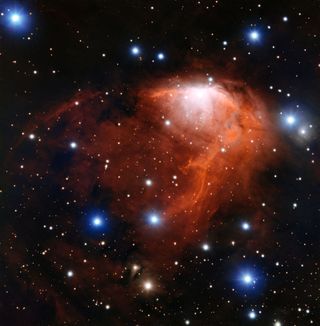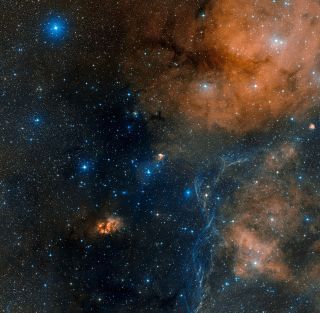Cheers! Bubbly 'Champagne Flow' of Stars Revealed in New Image, Video
A dramatic new picture of young stars shows captures a cosmic "champagne flow" as the stars blow away hot hydrogen gas around them.
The image was captured by the European Southern Observatory's Very Large Telescope in Chile, which spotted the stars inside the nebula RCW 34 in the southern constellation of Vela. ESO officials unveiled the image today (May 27) along with a video of the "champagne flow" in space.
When the gas reaches the edge of the nebula, it explodes into the vacuum of space in the "champagne flow" pattern, which gets its name because it leaves behind characteristic bubbles.

Usually, stars that are in the same cloud are expected to be about the same age. In the case of nebula RCW 34, however, astronomers can see hydrogen clumping around older stars embedded in the nebula, while hydrogen is less profuse at the outskirts.
This leads astronomers to suspect that there were several bursts of star formation, with the oldest stars in the middle representing the first wave.
"Vast amounts of dust within the nebula block the view of the inner workings of the stellar nursery deeply embedded in these clouds," ESO scientists said in a statement.

"RCW 34 is characterized by extremely high extinction, meaning that almost all of the visible light from this region is absorbed before it reaches Earth," they said. "Despite hiding away from direct view, astronomers can use infrared telescopes to peer through the dust and study the nest of embedded stars."
Get the Space.com Newsletter
Breaking space news, the latest updates on rocket launches, skywatching events and more!
The hydrogen in the cloud is ionized, meaning that it has been exposed to ultraviolet radiation and the hydrogen's electrons were stripped from the atoms.
Ionized hydrogen is common in star-forming regions. Stars are believed to form from the collapse of vast amounts of gas in a nebula, such as what is seen in the new image.
Follow Elizabeth Howell @howellspace, or Space.com @Spacedotcom. We're also on Facebook and Google+. Original article on Space.com.
Join our Space Forums to keep talking space on the latest missions, night sky and more! And if you have a news tip, correction or comment, let us know at: community@space.com.

Elizabeth Howell (she/her), Ph.D., was a staff writer in the spaceflight channel between 2022 and 2024 specializing in Canadian space news. She was contributing writer for Space.com for 10 years from 2012 to 2024. Elizabeth's reporting includes multiple exclusives with the White House, leading world coverage about a lost-and-found space tomato on the International Space Station, witnessing five human spaceflight launches on two continents, flying parabolic, working inside a spacesuit, and participating in a simulated Mars mission. Her latest book, "Why Am I Taller?" (ECW Press, 2022) is co-written with astronaut Dave Williams.












